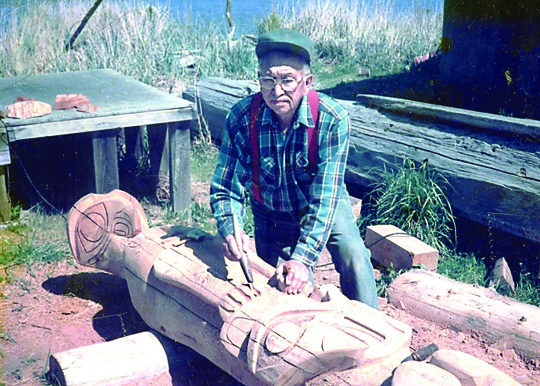PORT ANGELES — Three years ago, the late Harris “Brick” Johnson’s 19-foot totem pole, a gift to Peninsula College, was removed from the Port Angeles campus to make way for construction of the new Maier Performance Hall.
Then the pole, which Brick had presented to the college in 1971, was returned to the Johnson clan, who barely fit it into the old milking parlor on the family’s farm at Jamestown Beach outside Sequim.
At long last, following years of sanding, carving and repainting in that shed, Brick’s totem will come back home.
Tuesday ceremony
At 2 p.m. Tuesday, representatives of many tribes will gather — and the public is invited — to unveil and rededicate the restored pole in a ceremony outside Maier Hall on the campus at 1502 E. Lauridsen Blvd.
“My Uncle Brick was very inclusive and community-minded,” said Heather Johnson-Jock, the carver’s great-niece and a member of the Jamestown S’Klallam Tribal Council.
While serving on the college’s Board of Trustees from 1968 to ’78, Brick wanted to strengthen the relationship between the school and the Native Americans on the North Olympic Peninsula, Johnson-Jock said.
He carved a totem as a symbol of this so that any tribal member who saw it would feel at home.
At Tuesday’s rededication, Greig Arnold of the Makah tribe will serve as master of ceremonies, and Ben Charles, spiritual leader of the Lower Elwha Klallam tribe, will give the opening blessing.
Johnson-Jock, with Peninsula College President Luke Robins and former President Thomas Keegan, will offer a welcome.
Next will be a call for witnesses from the Hoh, Quileute, Makah, Port Gamble S’Klallam, Jamestown S’Klallam and Lower Elwha Klallam tribes.
Once the totem pole is unveiled, the celebration with singing, drumming, food and drink will start at the Pirate Union Building, and Pat Adams, spiritual leader of the Jamestown tribe, will give a traditional blessing of the food.
To restore the pole and research the figures it bears, Johnson-Jock sought to pull together as many family members as she could.
Her mother, Sandy Johnson; her aunts Verna Johnson, Vickie Carroll and Sue Johnson; and her uncle Terry Johnson — Brick’s nephew and protege — and other nieces, nephews and cousins worked together.
“We sanded every inch,” Johnson-Jock said, adding that the family also revisited the pole’s symbols.
Pole’s symbols
There is Eagle, for leadership and focus. The bird holds a small face figure representing the soul.
There’s the Medicine Man, who has another soul figure in his center, symbolizing the spirit called Skwe-dee-lich.
The Whale, guardian of the sea and protector of travelers, is here, too, along with Wolf, whose spirit helps people develop keen senses.
Another symbol of the soul is seen between the Wolf’s hind legs.
At Tuesday’s rededication, Johnson-Jock hopes people will gain a sense of the man who made this work of art and who was a powerful influence in her life.
“A lot of family members from that generation didn’t talk about who they were” as tribal members, she said. But Uncle Brick did.
“He was the one who inspired me to become an artist, too. When I had the opportunity to learn from master Salish weavers, I took hold of that. Now I’m a master weaver.”
There are a couple of stories about how Brick came by his nickname: One says his dark hair had a reddish cast, while the other is that he was hard on young people.
He urged them to stay in school and strive to excel — an administrator of “tough love,” Johnson-Jock said.
Tuesday’s gathering “is a reaffirmation of the partnership between the tribes and the college, and of how much Uncle Brick cared about education,” she added.
“It’s going to be a good day. I hope to see a lot of people there.”
________
Features Editor Diane Urbani de la Paz can be reached at 360-452-2345, ext. 5062, or at diane.urbani@peninsuladailynews.com.

